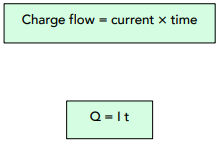Charge Flow Calculations (GCSE Physics)
Charge Flow Calculations
Calculating Charge Flow
We can measure current using the following equation:

Where:
- charge flow, Q, in coulombs, C
- current, I, in amperes, A (amp is acceptable for ampere)
- time, t, in seconds, s
1A means 1 coulomb of charge passes per second.
Question: Calculate the charge flowing through a circuit in 10 seconds if the current is 2 amperes.
1. Write out the equation.
Q = It
2. Substitute in the numbers.
Q = 2 x 10
Q = 20 coulombs
Question: A current of 2.5A flows into a television. How long would it take for 1200C of charge to flow through?
1. Write out the equation.
Q = It
2. Rearrange the equation.
Q = It
t = Q/I
3. Substitute in the numbers.
t = 1200/2.5
t = 480 seconds
Charge flow calculations are a fundamental concept in GCSE Physics that helps us determine the amount of electrical charge that flows through a conductor or a circuit in a given time. It is measured in coulombs (C) and can be calculated using the formula, Charge (C) = Current (A) x Time (s).
To calculate the current in a circuit, you need to know the voltage (V) and the resistance (R) of the circuit. Using Ohm’s Law, you can calculate the current (I) using the formula, Current (I) = Voltage (V) / Resistance (R).
Direct current (DC) flows in one direction only and is commonly used in batteries and electronic devices. Alternating current (AC) changes direction periodically and is used in the mains electricity supply.
To calculate the power in a circuit, you need to know the voltage (V) and the current (I) of the circuit. Using the formula, Power (P) = Voltage (V) x Current (I), you can calculate the power in watts (W).
In a series circuit, the components are connected in a single loop, and the current flows through each component in turn. In a parallel circuit, the components are connected in multiple branches, and the current is split between the branches.
To calculate the resistance of a component, you need to know the voltage (V) across the component and the current (I) flowing through it. Using Ohm’s Law, you can calculate the resistance (R) using the formula, Resistance (R) = Voltage (V) / Current (I).
Conductors are materials that allow electrical current to flow through them easily, such as metals. Insulators are materials that do not conduct electricity, such as rubber or plastic.
To calculate the potential difference (PD) in a circuit, you need to know the current (I) and the resistance (R) of the circuit. Using Ohm’s Law, you can calculate the potential difference (V) using the formula, Potential Difference (V) = Current (I) x Resistance (R).
Current is the flow of electric charge in a circuit, measured in amperes (A). Voltage is the potential difference between two points in a circuit, measured in volts (V).
A cell is a single unit that generates electrical energy, whereas a battery is made up of multiple cells connected in series or parallel to provide a larger power supply.





Still got a question? Leave a comment
Leave a comment